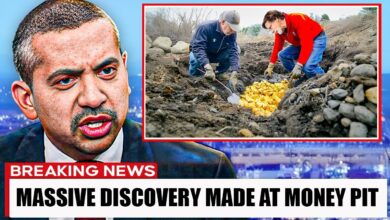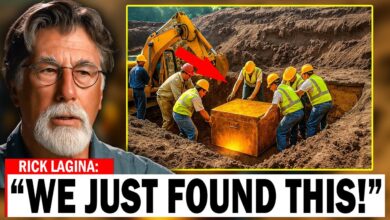The Curse of Oak Island: UNCOVERED ARTIFACT Provides a Big Clue (Season 9)
The Curse of Oak Island: UNCOVERED ARTIFACT Provides a Big Clue (Season 9)

So we’ll give it a go mate okay.
Rick Legena and metal detection expert Gary Drayton arrive at the uplands on Lot 15.
It was in this area,
what is this?
Where just one week ago, Gary and Peter Fernetti discovered an unusual iron band on nearby Lot 17, which once belonged to the wheel of an old cart or wagon.
This find not only dated to before the discovery of the money pit in 1795, but also offered evidence of a potential pathway between the swamp and the original treasure shaft.
To find this hidden road, it is Rick and Gary’s hope that uncovering a trail of pre-searcher artifacts between Lot 15 and the money pit could prove this theory to be true.
“We put flags on any target that sounds good to me.”
“And now we’ve got permission to dig them up, so all we got to do is see what they are, put them in a bag, mark them exact same as the flag, and bob’s your uncle. Okay, find something good.”
Metal detecting is different this year.
“We have to create transects or grids across the island.
We also have to get a permit from Community Culture and Heritage for that process to continue.”
“It’s in that area.”
In 2010, Rick, Marty, Craig, and their partners obtained permission from the government of Nova Scotia to search for treasure on Oak Island.
It is the only location within the province where such activities are legal.
At the time, other than the late 18th century homesteads that once belonged to Samuel Ball on Lot 25 and Daniel McGinnis on Lot 21,
they were subject to few restrictions regarding metal detecting activities across their property.
That all changed in the wake of the historic discoveries the team made last year in the swamp,
such as the massive stone road and the cobblestone pathway which may be leading in this direction on Lot 15 and potentially even toward the original money pit.
“I think the arising awareness in the public of how important this might be has caused regulators to sit up and pay attention, in large part due to the success of us making this real.”
Now, other than a designated green zone, which covers the money pit area from Lot 18 to Smith’s Cove on Lot 20,
Gary must first mark metal targets that he detects with flags,
and then obtain permission from archaeologist Laird Niven to go back and retrieve whatever they may be.
[Music]
“Oh, our old friend the pull tab. Oh, imagine that.”
By getting tagged, even though it’s trash.
“Yeah, I think issues like this need to be addressed with CCH. This just seems like a waste of time and assets.”
“Yeah, we have to really dig through the trash to get to the treasures.”
“My hope is that the positive will outweigh the negative, but to be honest, it will slow down the work.”
“Yeah, it’s like a scrap yard around there.”
“Right, next flag is just here. Just here.”
[Music]
“That sounds even better.”
“Oh, look at that. Oxy.”
“That looks like an oldie. Crazy, isn’t it?”
“So all that modern junk, and then we get an older rock shoe in this area.”
“Yeah, we’re not too far off a money pit as well, and we found all those octopus down below the so-called pine tar kiln.”
“Yeah, an ox shoe.”
Since the team has found a number of ox shoes over the last year on the island,
might it be more evidence of not just a path between the swamp and the money pit,
but also an operation to haul heavy cargo between the two locations as well?
“That’s cool. That’s what we want to be finding, some old stuff. And I knew there had to be some more old stuff in here. It’s just clearing all this out.”
“And unfortunately, somewhere like this, we’re gonna have to take all the surface junk out to get to the good stuff.”
“Where you find ox shoes, you’re in an area which could potentially be a trail or an area where treasure was old, perhaps.”
“So, this is exciting. What is that? French? British? To me, it looks British because it’s got that wider bottom and that thinner top.”
If Gary’s assessment about this ox shoe’s origin is correct, could that mean it may be connected to the British pine tar kiln that the team found on Lot 15 last year?
The same one that archaeologist David McGinnis believes to date back as far as the 16th century,
and which Laird Niven suspects may have been used in the construction of the original money pit?
“You should go back to the old aerials. Plot this, these fines, against the old aerials where it’s cleared.”
“Yeah, let’s see if they correspond.”
“Yeah.”
“Oh, that’s good. We know someone was here using an ox a long time ago.”
“That’s bad, mate. These are the type of finds we wanna be recovering. I knew we could sniff out an old fight.”
“On to the next flag.”



